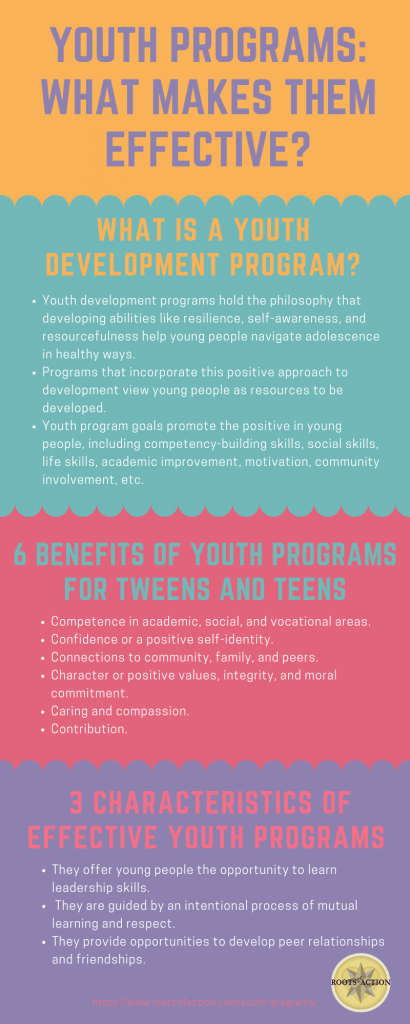
Youth programs abound today, claiming numerous positive outcomes for adolescents.
What tweens and teens learn in youth programs can help them develop better social skills, become leaders, gain greater knowledge of themselves, and foster lifelong relationships.
But programs vary widely in quality. What makes youth programs effective? How do you know if they are a good fit?
Finding meaningful and potentially transformative youth programs can be challenging. There are many choices, including sports, camps, arts programs, and volunteering. Helping find the perfect fit is an important role for parents, grandparents, teachers, and other mentors. Offering advice can make a difference – pointing young people to activities that are not only fun but also offer opportunities to develop character strengths, skills, and abilities that will last a lifetime.
Research through the nonprofit America’s Promise suggests that 5 Promises change kid’s lives: 1) Caring adults, 2) Safe places, 3) A healthy start, 4) Effective education, and 5) Opportunities to help others. Youth programs play an important role in keeping these promises to our kids.
Why are Youth Programs Important?
Youth programs offer huge benefits to tweens and teens. Researchers refer to the Six C’s—desired outcomes that many youth programs provide to young people:
- Competence in academic, social, and vocational areas.
- Confidence or a positive self-identity.
- Connections to community, family, and peers.
- Character or positive values, integrity, and moral commitment.
- Caring and compassion.
- Contribution.
As children grow to middle and high school age, they seek more autonomy and independence. They naturally react against authority and the kinds of structure found in programs for younger children. Not surprisingly, these youth program qualities benefit teens developmentally.
Youth programs are important because they can help build these Six C’s, preparing adolescents for a variety of roles they assume as they reach college-age and the workforce.
What is a Youth Development Program?
Youth development programs hold the philosophy that developing abilities like resilience, self-awareness, resourcefulness, and other attributes of The Compass Advantage framework, help young people navigate adolescence in healthy ways. There is an important difference between youth development programs and a variety of other organized programs that may offer youth activities or strategies to prevent high risk behaviors.
Programs that incorporate this positive approach to development view young people as resources to be developed rather than as problems to be corrected. Their goals are to promote the positive in young people, including competency-building skills, social skills, life skills, academic improvement, motivation, community involvement, etc. These kinds of programs have evolved by applying the research in positive youth development to youth programming.
While preventative youth programs can also help build the Six C’s, their stated goals are focused on preventing or stopping problem behavior. For example, these types of youth programs may reduce substance abuse, violence, school dropout, gang activity, early childbearing, etc.
Knowing a child, listening to their needs, and exploring a variety of youth programs is the first step to making informed decisions. Sometimes, teens need a prevention vs. a youth development program, or a combination of both.
Three Characteristics of Effective Youth Programs
Research studies that evaluate youth development programs consistently highlight three things that attract teens and keep them engaged over time. When young people have opportunities for leadership, understanding, and friendship, it can help them navigate adolescence in ways that advance their skills and feel good about themselves.
Not surprisingly, these program qualities were discussed by many young people who were interviewed in my book, Tomorrow’s Change Makers: Reclaiming the Power of Citizenship for a New Generation. Several of their quotes are included below.
When evaluating the effectiveness of youth development programs, ask these three questions:
1. Are there Opportunities for Youth Leadership?
One of the most important aspects of youth programs for older kids is whether they offer young people the opportunity to learn leadership skills. Research suggests that adolescents should be provided with meaningful ways to assist in leading activities, contribute to program decision-making, and play an active role in making the program a success. When this occurs, young people learn to overcome challenges in the real world, like how to communicate and collaborate with others outside of their families and close circle of friends.
Victor, age 19, participated in numerous summer youth programs and volunteer activities during high school, including working in a hospital emergency room, at a petting zoo, and tutoring children. He also took advantage of Kiwanis youth programs and became a Key Club leader. Reflecting on these experiences, he said: “I believe that having the opportunities to both serve and lead at many levels had a strong shaping effect on who I am as a leader and a person today.”
2. Are there Opportunities for Understanding?
Teenagers need to be understood and appreciated for who they are, not just for their grades or how well they do in sports and other activities. Research shows that older youth respond best to youth programs that are guided by an intentional process of mutual learning and respect. That is, they like structure that encourages interaction between them and youth program staff where staff take the time to get to know them in depth, learn about their interests, and appreciate them as individuals. These nurturing relationships help young people believe in themselves and foster the development of identity.
Scott, age 20 reinforces the importance of having adults who understand youth. Speaking of a youth program he started in middle school, he said, “They met me at my level.” Although he was shy, program staff helped him “stretch my rubber band a little bit,” encouraging him to stretch his boundaries and learn about himself. He remains forever grateful for people who took the time to get to know him.
3. Are there Opportunities for Friendships?
Older students are motivated to participate in programs that provide opportunities to develop peer relationships and friendships. Developing these relationships is important to their self-esteem and self-worth. Finding youth programs that have been referred by friends or where friends are already involved can be a good way to evaluate the quality of the program. It can also help your teen stretch his or her comfort zone to try something new.
Young people often talk about the importance of working side by side with friends. Bryon, age 18, who participated in JROTC during high school, talked about a friend who influenced him to try new activities. “And when he became the Key Club president, I worked a lot with him and we did a lot of joint projects together. We did more projects because of how much we liked working together.”
Youth Programs Infographic
Please feel free to use or share this infographic, a summary of the points in this article.
References
Arbreton, A., Bradshaw, M., Sheldon, J., & Pepper, S. (2009). Making every day count: Boys & Girls Clubs’ role in promoting positive outcomes for teens. Philadelphia: Public/Private Ventures.
Deschenes, S. N., Arbreton, A., Little, P. M., Herrera, C., Grossman, J. B., & Weiss, H. B., with Lee, D. (2010). Engaging older youth: Program and city-level strategies to support sustained participation in out-of-school time. Cambridge, MA: Harvard Family Research Project.
Lerner, R. M., Fisher, C. B.,& Weinberg, R. A. (2000). Toward a science for and of the people: Promoting the civil society through the application of developmental science. Child Development, 71, 11–20.
Pittman, K. J., Irby, M., Tolman, J., Yohalem, N., & Ferber, T. (2001, September). Preventing problems, promoting development, encouraging engagement: Competing priorities or inseparable goals? The Forum for Youth Investment.
Price-Mitchell, M. (2010). Civic learning at the edge: Transformative stories of highly engaged youth. Doctoral Dissertation, Fielding Graduate University, Santa Barbara, CA.
Roth, J. L. and J. Brooks-Gunn (2003). “What Exactly Is a Youth Development Program? Answers From Research and Practice.” Applied Developmental Science 7(2): 94-111.
Russell, C. A., Mielke, M. B., & Reisner, E. R. (2009). Evidence of program quality and youth outcomes in the DYCD Out-of-School Time Initiative: Report on the initiative’s first three years. Washington, DC: Policy Studies Associates.
Related Articles You May Enjoy
Published: January 7, 2020
Tags: mentoring, parenting, summer programs



